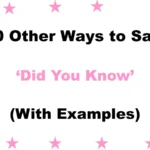Expressing gratitude in the right way is a powerful tool for building connection and showing genuine appreciation. Saying “Thank you for the update” is common, but finding other ways to say this can make your communication feel more warm, personal, and thoughtful.
Whether in professional or personal settings, choosing the right phrase can convey respect, attentiveness, and kindness, making the receiver feel truly valued. This article offers 30 alternatives to thank you for the update — each carefully explained with examples to help you express gratitude with care and authenticity.
What Does “Thank You for the Update” Mean?
“Thank you for the update“ is a polite way to express appreciation when someone shares new information or progress with you. It acknowledges their effort in keeping you informed and shows that you value their communication.
This phrase helps maintain a positive connection by recognizing the importance of staying updated. It’s often used in both personal and professional conversations to show gratitude.
When to Use “Thank You for the Update”
You use “Thank you for the update” whenever someone provides you with new information, progress reports, or changes related to a situation, project, or event. It’s especially helpful in professional settings like work emails or meetings, where staying informed is crucial.
It can also be used in personal conversations to acknowledge that someone has taken the time to keep you posted. This phrase works well whenever you want to show appreciation for clear and timely communication.
Is It Professional/Polite to Say “Thank You for the Update”?
Yes, “Thank you for the update” is both professional and polite. It shows respect and appreciation for someone’s effort in keeping you informed. Using this phrase helps maintain positive communication in the workplace and fosters a collaborative environment. It’s a simple yet effective way to acknowledge timely and helpful information.
Pros and Cons of Saying “Thank You for the Update”
Pros:
- Simple and clear
- Polite and professional
- Shows attentiveness
Cons:
- Can feel repetitive or generic
- May lack warmth or personality if overused
Synonyms for “Thank You for the Update”
- Thanks for keeping me posted
- Appreciate the information
- Grateful for the update
- Thanks for the heads-up
- Thanks for sharing the details
- Many thanks for the update
- I appreciate the latest info
- Thanks for letting me know
- Thank you for the insight
- Thanks for filling me in
- Appreciate you keeping me in the loop
- Thanks for the timely update
- Grateful for the news
- Thanks for the report
- Thank you for the briefing
- Appreciate the status update
- Thanks for the feedback
- Thank you for keeping me informed
- Thanks for the update, much appreciated
- I’m grateful for the heads-up
- Thank you for the communication
- Thanks for your update
- Appreciate your keeping me advised
- Thank you for the progress report
- Thanks for your message
- Appreciate the recent information
- Thank you for the summary
- Thanks for the latest update
- Appreciate your timely communication
- Thank you for keeping me updated
1. Thanks for keeping me posted
Definition: A casual way to thank someone for continuously providing information.
Explanation: This phrase conveys gratitude for ongoing updates, showing you value staying informed.
Example: Thanks for keeping me posted on the project’s progress.
Best Use: Informal or semi-formal situations where updates happen regularly.
Worst Use: Formal or highly professional contexts might require something more polished.
Tone: Friendly, approachable.
2. Appreciate the information
Definition: A simple, direct way to express thanks for the information provided.
Explanation: It shows gratitude without being overly formal.
Example: Appreciate the information you sent over this morning.
Best Use: When you want to keep it professional but warm.
Worst Use: Too brief for deeply personal communications.
Tone: Professional yet warm.
3. Grateful for the update
Definition: A more heartfelt expression of thanks for receiving an update.
Explanation: Adds a tone of sincerity and appreciation.
Example: I’m grateful for the update on the schedule change.
Best Use: When you want to sound genuinely thankful.
Worst Use: Avoid if the situation is casual or requires brevity.
Tone: Sincere, warm.
4. Thanks for the heads-up
Definition: A casual, informal way to thank someone for advance notice or warning.
Explanation: Indicates appreciation for proactive communication.
Example: Thanks for the heads-up about the meeting time.
Best Use: Informal communication, especially among colleagues or friends.
Worst Use: Too casual for formal business emails.
Tone: Informal, friendly.
5. Thanks for sharing the details
Definition: Expresses thanks specifically for detailed information provided.
Explanation: Acknowledges effort in providing thorough updates.
Example: Thanks for sharing the details of the event.
Best Use: When detailed or complex info is shared.
Worst Use: Too wordy for brief updates.
Tone: Appreciative, professional.
6. Many thanks for the update
Definition: A polite, slightly formal way to thank someone for the update.
Explanation: Conveys gratitude in a respectful and sincere way.
Example: Many thanks for the update on the project timeline.
Best Use: Formal or business communications.
Worst Use: Might feel too formal in casual settings.
Tone: Respectful, polite.
7. I appreciate the latest info
Definition: Expresses gratitude specifically for the most recent information.
Explanation: Shows that you value current and relevant updates.
Example: I appreciate the latest info on the delivery schedule.
Best Use: When emphasizing timeliness.
Worst Use: May sound too casual for formal contexts.
Tone: Friendly, professional.
8. Thanks for letting me know
Definition: Simple and direct thanks for providing information.
Explanation: Shows appreciation for the communication.
Example: Thanks for letting me know about the change in plans.
Best Use: Casual to semi-formal contexts.
Worst Use: May feel too brief or casual in formal emails.
Tone: Friendly, clear.
9. Thank you for the insight
Definition: Thanks for providing useful or thoughtful information.
Explanation: Implies that the update offered understanding or clarity.
Example: Thank you for the insight on the market trends.
Best Use: When the update helps decision-making.
Worst Use: Not suitable for simple status updates.
Tone: Professional, thoughtful.
10. Thanks for filling me in
Definition: Informal thanks for bringing someone up to date.
Explanation: Casual way to appreciate getting informed.
Example: Thanks for filling me in on what happened at the meeting.
Best Use: Informal or casual communication.
Worst Use: Avoid in highly formal situations.
Tone: Casual, friendly.
11. Appreciate you keeping me in the loop
Definition: Thanking someone for continuous communication and updates.
Explanation: Shows gratitude for being regularly informed about ongoing developments.
Example: Thanks for keeping me in the loop about the project deadlines.
Best Use: In ongoing projects or situations needing frequent updates.
Worst Use: Overuse can make it sound repetitive.
Tone: Warm, collaborative.
12. Thanks for the timely update
Definition: Expressing thanks for receiving information promptly.
Explanation: Emphasizes appreciation for receiving information when it is most useful.
Example: Thanks for the timely update on the client’s feedback.
Best Use: When timing of information delivery is crucial.
Worst Use: Not suitable for delayed or outdated information.
Tone: Professional, appreciative.
13. Grateful for the news
Definition: A heartfelt way to thank someone for sharing new information.
Explanation: Expresses sincere gratitude for receiving updates or news.
Example: Grateful for the news about the team’s progress.
Best Use: When the update carries significance or importance.
Worst Use: May sound too formal for everyday casual updates.
Tone: Sincere, thoughtful.
14. Thanks for the report
Definition: Thanking someone for providing a structured or formal update.
Explanation: Suitable when information is given in a report format.
Example: Thanks for the report on last quarter’s sales figures.
Best Use: Professional or business contexts involving reports.
Worst Use: Too formal for informal chats or brief updates.
Tone: Formal, respectful.
15. Thank you for the briefing
Definition: Expressing appreciation for a detailed summary or explanation.
Explanation: Shows gratitude for a concise and clear update.
Example: Thank you for the briefing before today’s meeting.
Best Use: Formal settings where a summary or overview is provided.
Worst Use: Too formal for casual updates.
Tone: Professional, courteous.
16. Appreciate the status update
Definition: Thanking someone for providing a current progress report.
Explanation: Recognizes effort in keeping others informed about status.
Example: Appreciate the status update on the software development.
Best Use: Project management and workplace communication.
Worst Use: Not ideal for personal or informal contexts.
Tone: Professional, appreciative.
17. Thanks for the feedback
Definition: Expressing gratitude for information given as a response or opinion.
Explanation: Useful when updates include opinions or suggestions.
Example: Thanks for the feedback on my presentation draft.
Best Use: When the update contains evaluative comments or advice.
Worst Use: Avoid if the update is purely informational without feedback.
Tone: Polite, professional.
18. Thank you for keeping me informed
Definition: A polite way to thank someone for ongoing updates.
Explanation: Shows appreciation for being regularly informed.
Example: Thank you for keeping me informed about the contract negotiations.
Best Use: Professional and personal communication needing frequent updates.
Worst Use: Could sound formal in very casual conversations.
Tone: Polite, respectful.
19. Thanks for the update, much appreciated
Definition: A warm and sincere way to say thanks.
Explanation: Adds extra emphasis on the value of the update.
Example: Thanks for the update, much appreciated as always.
Best Use: When you want to add warmth and sincerity.
Worst Use: Can feel repetitive if overused.
Tone: Friendly, heartfelt.
20. I’m grateful for the heads-up
Definition: Thanking someone for advance notice or warning.
Explanation: Shows appreciation for being warned or informed early.
Example: I’m grateful for the heads-up about the schedule change.
Best Use: When the update is a warning or preparation notice.
Worst Use: Too informal for strict professional contexts.
Tone: Casual, grateful.
21. Thank you for the communication
Definition: A formal way to thank someone for sharing information.
Explanation: Emphasizes appreciation for the act of communicating.
Example: Thank you for the communication regarding the policy updates.
Best Use: Formal emails and official correspondence.
Worst Use: Too formal for informal texts or chats.
Tone: Formal, respectful.
22. Thanks for your update
Definition: A simple and polite acknowledgment of the information shared.
Explanation: Direct and to the point.
Example: Thanks for your update on the project status.
Best Use: When brief acknowledgment is sufficient.
Worst Use: May seem curt in deeply personal conversations.
Tone: Polite, neutral.
23. Appreciate your keeping me advised
Definition: A formal phrase showing thanks for regular updates.
Explanation: Suitable for ongoing communication and advice.
Example: Appreciate your keeping me advised throughout the process.
Best Use: Professional settings with continuous updates.
Worst Use: May sound too formal or old-fashioned in casual contexts.
Tone: Formal, professional.
24. Thank you for the progress report
Definition: Thanks specifically for an update on development or progress.
Explanation: Acknowledges detailed information about advancement.
Example: Thank you for the progress report on the renovation project.
Best Use: Work or project-related updates.
Worst Use: Not suitable for informal updates.
Tone: Professional, appreciative.
25. Thanks for your message
Definition: A general thank you for any kind of update or information.
Explanation: Simple and versatile.
Example: Thanks for your message about the meeting location.
Best Use: Casual to semi-formal messages.
Worst Use: May lack warmth for important updates.
Tone: Neutral, polite.
26. Appreciate the recent information
Definition: Shows gratitude for the latest shared details.
Explanation: Highlights value of the most current update.
Example: Appreciate the recent information regarding the budget.
Best Use: Formal and professional communications.
Worst Use: Might sound stiff in casual talk.
Tone: Polite, professional.
27. Thank you for the summary
Definition: Thanks for a concise overview or recap.
Explanation: Shows gratitude for a clear and brief update.
Example: Thank you for the summary of today’s conference.
Best Use: Formal meetings, reports, or briefings.
Worst Use: Too formal for informal updates.
Tone: Professional, courteous.
28. Thanks for the latest update
Definition: Simple thanks specifically for the newest information.
Explanation: Emphasizes appreciation for the most recent data.
Example: Thanks for the latest update on the delivery status.
Best Use: Informal to semi-formal situations.
Worst Use: May be too generic for formal reports.
Tone: Friendly, clear.
29. Appreciate your timely communication
Definition: Thanks for prompt and efficient information sharing.
Explanation: Recognizes the value of timely updates.
Example: Appreciate your timely communication during this project phase.
Best Use: Professional contexts where timing matters.
Worst Use: Not appropriate if the update was late.
Tone: Formal, appreciative.
30. Thank you for keeping me updated
Definition: A warm, polite way to thank someone for ongoing updates.
Explanation: Conveys gratitude for continued information sharing.
Example: Thank you for keeping me updated throughout the negotiations.
Best Use: Both professional and personal ongoing updates.
Worst Use: Overuse can make it less impactful.
Tone: Friendly, polite.
Conclusion
Choosing the right way to say “Thank you for the update” allows you to communicate with greater warmth and intention. Each alternative phrase fits different situations, tones, and levels of formality, helping you to express your appreciation authentically and thoughtfully.
Using varied expressions not only keeps your communication fresh but also deepens connections by showing that you truly value the effort to keep you informed. Keep these phrases handy to ensure your gratitude is always meaningful and clear.
FAQs
Q1: Why is it important to use different ways to say “Thank you for the update”?
Using varied expressions shows that you care about the message and the person sharing information. It helps keep communication fresh, personal, and meaningful rather than repetitive or robotic.
Q2: Can I use these alternative phrases in professional emails?
Yes! Many of the alternatives are suitable for professional settings, helping you maintain politeness and professionalism while sounding warm and approachable.
Q3: How do I know which phrase to use in different situations?
Consider the tone of your relationship and the context. For formal settings, choose polite and clear alternatives. For casual conversations, feel free to use more friendly or relaxed expressions.
Q4: Are these alternatives appropriate for texting or informal communication?
Absolutely! Some alternatives are perfect for quick texts or informal chats, helping you show gratitude in a genuine and conversational way.
Q5: Can using varied phrases improve my communication skills?
Definitely. Using different expressions not only prevents your language from sounding repetitive but also helps you express empathy and attention to detail, strengthening your relationships.

Mia Rose is a passionate Language Coach and Contributor at GrammarPeaks, where she specializes in practical grammar tips and language learning strategies. With a strong foundation in education and communication, Mia brings a friendly, approachable style to her writing. Her goal is to make complex grammar rules simple and usable for learners at any level, helping them grow in both confidence and fluency.





